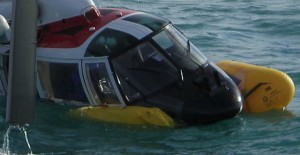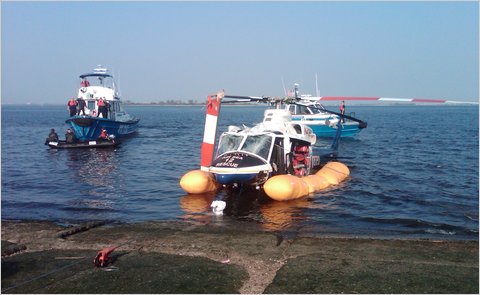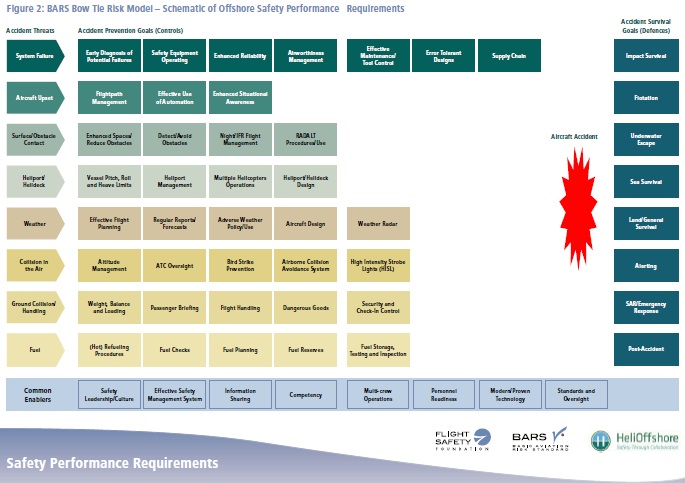Offshore Helicopter Emergency Response
Maintaining an effective emergency response capability is critical to any organisation contracting for helicopter operations in a hostile environment.

Wreckage of DRF BK117 D-HDRJ in Feb 2014 (Credit: BFU) – Note: BFU traditionally eliminate all reference to aircraft registration from their accident reports
Among the key questions they need to ask are:
- How will we be alerted?
- What assets are available for search and rescue?
- Have we documented, but more importantly TESTED, our Emergency Response Plan (ERP)?
Alerting
While aircraft carry Emergency Locator Transmitters (ELTs), in sudden accidents they have historically proven unreliable.
An Aerossurance study of helicopter accidents in the Gulf of Mexico showed that most fixed ELTs failed to activate automatically. Controlled ditchings turned out to be too ‘soft’ to activate the ‘g’ (or ‘crash’) switch.
Often the ELT transmitter is mounted forwards but the antenna in on the tail boom, and so the cabling does not survive a ‘more dynamic’ accident.
Even if activated (automatically or manually) ELT’s do not work when they are submerged. So if the emergency flotation system does not fully deploy then even a perfectly functioning ELT will be lost below the waves before a satellite fix can be obtained, putting the emphasis on Survival ELTs carried by the crew or in life rafts.
While Automatically Deployable ELTs (ADELTs) have been common in Europe and on large offshore helicopters, their performance has been patchy as described by UK CAA in CAP1144. The European Aviation Safety Agency (EASA) have a Rule Making Team (RMT.0274) looking ‘ELT installation, location and activation’ generally.
A reliable method of tracking is to use a satellite tracking system. Although there was much debate after the MH370 accident of making satellite tracking mandatory for airliners, extremely cost effective technology is available today and widely used in the oil & gas and resource sectors on helicopters and fixed wing aircraft. Using sat tracking means that no matter what happens to the aircraft when an accident occurs, the track up to that point is captured back at a monitoring centre, greatly aiding the search and rescue effort.
Simply fitting the kit is only part of the story however.
One choice is the frequency of position updates. Most sat tracking providers charge for each position transmission. While reputable air operators recognise the benefit of regular position reports it has been know for some operators to pay for the minimum (the difference between a 2 minute and a 15 minute interval could be 35nm for a modern offshore helicopter). As a customer for air services, not only is it wise to specify sat tracking but also agree a transmission frequency.
Another factor is who is going to monitor the progress of a flight and what do they do if an anomaly occurs? Accidents have occurred where the system was unmonitored and no automated alarms were set up. One example is a helicopter accident in Canada in 2011 during an onshore geological survey. In a similar case that Aerossurance investigated, while a dedicated flight following centre was monitoring a flight, when it crashed alongside is destination, an emergency response was delayed on the assumption the aircraft had landed as intended.
Search and Rescue (SAR)
SAR assets around the world vary from dedicated, regularly exercised All Weather SAR (AWSAR) helicopters with paramedic trained winchmen, four axis autopilot, dual hoists, FLIR, direction finding equipment etc on constant short notice stand-by (as illustrated above) to…well…next to nothing.
Relying on a local military that flies a few hundred hours a year, has a winch (in their stores!), but has not trained with it for years is trusting hope over reality.
Increasingly it is recognised that in remote locations a SAR capacity is necessary to support exploration contracts. Depending on the local circumstances this can range from having a winch equipped Limited SAR (LIMSAR) helicopter on stand-by during crew change flights, to having a full AWSAR capability that would be the envy of many nation states (see: Increasing SAR Use by the Oil & Gas Industry and The Tender Trap: SAR and Medevac Contract Design). Such a capability is available to mitigate other risks in an offshore safety case too (from medevacs to a man over board situation to a major installation emergencies).
It is important to remember that irrespective of the helicopter SAR capability, all offshore exploration and production is supported by offshore supply vessels and other marine assets. It is vital to have a proven method to coordinate these in the event of a ditching to ensure a prompt rescue. In the case of an accident off Takoradi, Ghana in 2014 other oil and gas companies in the area cooperated in the maritime search.
Preparation and training remains key (if an accident occurs in poor visibility and SAR helicopters are hovering low, there is a risk of poor coordination leading to a ship/helicopter collision!).
Emergency Response Plans (ERPs)
The most common audit findings on ERPs are:
- They don’t exist
- They were written by someone who has never been to the location, never will and will certainly never get ‘the call’!
- They do exist but are light on detail and ignore credible scenarios
- They only work in ‘ideal conditions’ (like an accident at 10am on a Monday morning when HQ is fully staffed not 10pm on a Saturday night of a public holiday weekend)
- They have out of date information (especially contact details)
- Key personnel aren’t familiar with them (or don’t even have access to a copy!)
- They have never been tested
Additionally customers for offshore helicopters often have not adjusted their ERPs to address aviation specific issues.

Icelandic Coast Guard Aérospatiale SA365N Dauphin TF-SIF in the Atlantic off Reykjavik on 16 July 2007 (Credit: via RNF)
An ERP that has never been tested is as good as useless as no ERP ever survives its first exercise unchanged. Testing should start with a desktop walk through (an ideal was to get you ERP team familiar with the plan and take some ownership for improving it). Then move to a partial exercise in ‘near real time’ with some role play and reaction to emerging information. Finally, a full exercise, with assets being deployed if possible and liaison with 3rd parties.
Final Word
To better understand the recovery measures after an offshore helicopter accident we recommend the Flight Safety Foundation (FSF) Basic Aviation Risk Standard for Offshore Helicopter Operations (BARSOHO), launched in May 2015. It is loosely based on their of their award winning Basic Aviation Risk Standard, used in the mining industry, but tailored to offshore operations. The standard is orientated around a risk bow-tie, contains a number of common and specific threat controls as well as recovery measures (grouped in distinct categories, for survival after an offshore accident):
BARSOHO Version 3, fully aligned with the HeliOffshore Safety Performance Model (SPM) and includes appendices for SAR, transport hoisting and medevac.
The whole BARSOHO standard is available free to download, with an accompanying implementation guide.
UPDATE 4 October 2017: Irish Coast Guard (IRCG) Select Aerossurance as SAR Aviation Consultancy
UPDATE 11 May 2020: European Search and Rescue (SAR) Competition Bonanza
SAR Consultancy: Procurement, Tenders, Contacts and In-Service Assurance and Aviation Advice
In September 2017 one European Coast Guard selected Aerossurance to be their new aviation consultants after a competitive tender with 7 bidders. In July 2018 Aerossurance started work supporting a second European Coast Guard with a procurement project. The Aerossurance team is and has supported humanitarian aid agencies, air ambulance charities, military air arms, environmental agencies and blue chip energy companies on other emergency service and special mission aviation projects around the world.
The Tender Trap: SAR and Medevac Contract Design: Aerossurance’s Andy Evans discusses how to set up clear and robust contracts for effective contracted SAR and HEMS operations.



Recent Comments